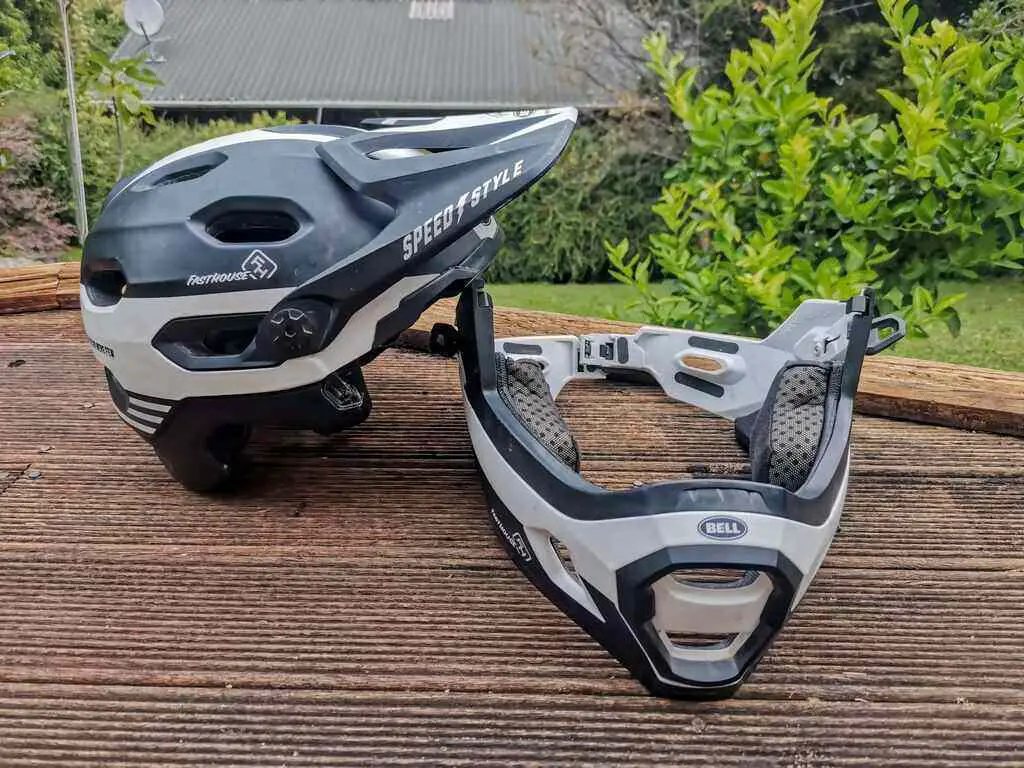These days helmets are not only highly protective, but they are also extremely practical. The convertible mountain bike helmet is an outstanding example of this. We have determined the best five convertible MTB helmets to share with you.
A convertible helmet is one with a detachable chin bar. This allows you to detach the bottom portion of the helmet. In doing so, it makes it easier to ride up hills and prevents you from overheating. You can then reattach the bottom portion to form a full face helmet for the descent.
The detachable chin bar has come a long way since the first model, the 1998 Giro Switchback. The helmets are breathable, lightweight, and rather good-looking. They are also simple to detach and reattach the bottom portion.
Why Purchase A Convertible Mountain Bike Helmet?
Initially designed for enduro riders, the convertible mountain bike helmets have become a big player in the downhill helmet market. For a very good price, you not only get a great full-face lid, but you also get a high-end open-face helmet.
I have been using a detachable full face for the past three years, and have not looked back. I purchased it as the old open face was getting a bit worn out. And since I had started riding chairlift laps at the local bike park, I figured a full-face was probably necessary.
The convertible bike helmets met both these criteria, providing me with a very comfortable, safe open-face helmet. And, it had the added benefit of becoming a full-face when I needed it.
The advantages became even more apparent when I realized how helpful it was riding out to the park from home (a good 20 minutes). I would ride out with the chin bar around my handlebars, and not having the full face obstructing my view of cars while on the road. I’ve since managed to convince most of my friends to purchase one!
The chin bar is very easy to attach (takes around 30 seconds), which I will often do while on the chairlift.
So what is the catch?
Two things would typically defer riders from purchasing a convertible lid:
First, the price. The price can be upwards of double a typical half shell helmet, and will likely cost a bit more than a downhill helmet. But… still cheaper than buying the equivalent half shell and a full face.
Secondly, the perceived safety of a convertible lid compared to a designated full face helmet. People are worried that the helmet will be flimsy, or not meet the same safety standards as a full face. You do need to check the safety ratings, there are (at least) two ratings which separate downhill certified helmets (which are tested to a higher safety standard- read more about it here) and standard safety ratings. We have identified what helmets have what rating below.
Top Six Convertible Mountain Bike Helmets
Here we have collected the four best convertible mountain bike helmets in the market at the moment. We have also reviewed each one so that you know you are purchasing the right one for your needs.
Bell Super DH MIPS Helmet Review
- Rating: 4.5/5 – Most Popular
- Weight: 850 g
- Downhill Certified: Yes
- Rotational Impact System: MIPS Spherical
Bringing together the best of both worlds, a detachable chin bar makes for an easy climb and a safe descent. For the price of one, you get a top-of-the-line open face helmet and a fully certified downhill helmet that is comfortable, durable, and easy to use.
Pros
- Durable
- Comfortable
- MIPS Spherical
- Downhill Certified
Cons
- Heavier than the Bell Super 3R and Leatt DBX 3.0
Bell has made a couple of outstanding helmets in this field including the ‘Super’ field. They have the Super DH, the Super Air R and the Super 3R. The Super DH stands apart from the field as it is downhill certified.
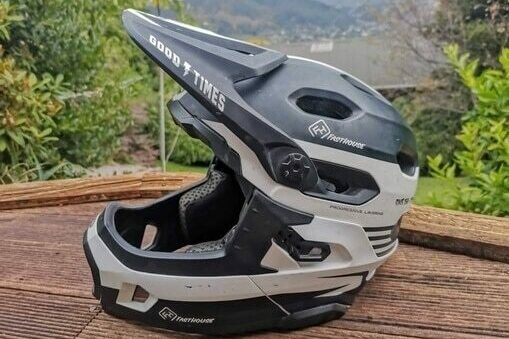
Features of the Super DH
The Bell Super DH is a well kitted-out lid, with an adjustable visor that goes high enough to store goggles beneath it. The retention dial is easy to adjust while riding, even with gloves on. And as a bonus, Bell have used the Fidlock magnetic buckle, which is a simple and secure way of doing up the buckle beneath your chin.
It sits close to the head, rather than sitting on top of the head, with deep rear coverage as an open face. The padding inside the helmet is comfortable, durable, and it does not obstruct ventilation. One of the most well-designed parts of the helmet is that you can remove the chin bar without even taking the helmet off. It is that easy!
Safety Features of the Super DH
In terms of safety features, the Bell Super DH has the more recent MIPS Spherical. This has two layers of EPS foam with an invisible low-friction layer between them, creating a ‘ball and socket’ type system. As the MIPS Spherical does not have a plastic liner like the standard MIPS, the ventilation is much better.
The big advantage of this in terms of safety is that there are now two layers of foam protecting your head. The outer layer, constructed of EPS (Expanded Polystyrene) foam, is a harder foam compared to the inner layer of EPP (Expanded Polypropylene). The combination of the two reduces the energy over a much wider range of impact.
This means crashes at high speeds and low-speed, rotational, and direct impacts, are addressed by the MIPS Spherical system.
The Super DH is also constructed with in-mold technology (fusion of the outer plastic shell to the EPP foam), which improves its durability and safety in the event of a crash.
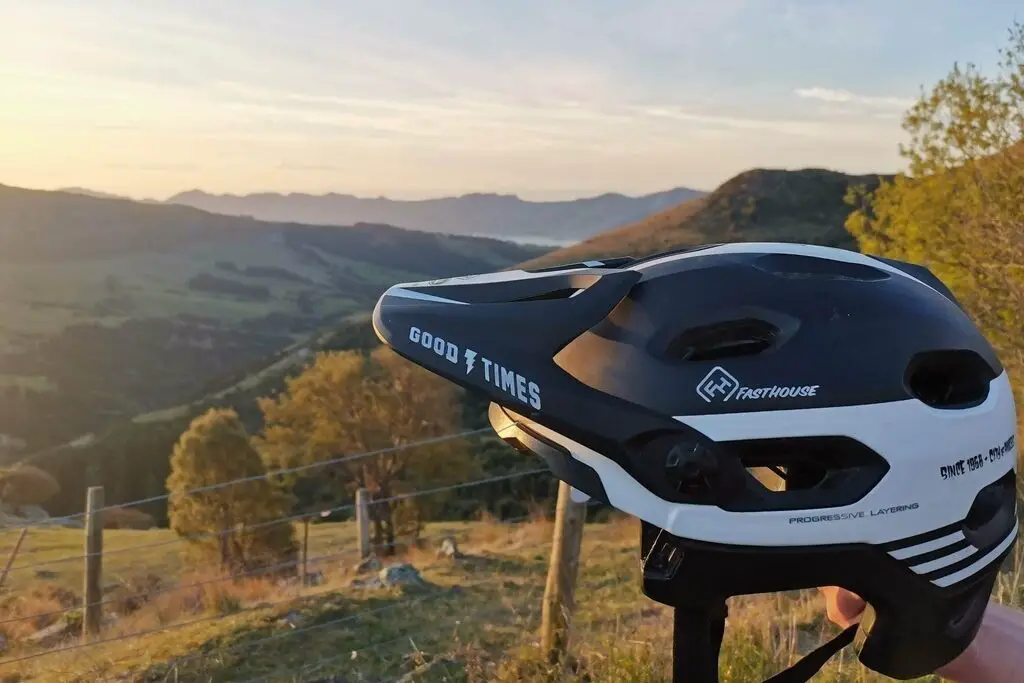
Ventilation
A lot of thought has gone into the ventilation of the helmet. Not only are there 19 decently sized vents, but the gap between the spherical layers contributes to the internal channeling of the airflow.
There are also two ports on the brow and four on the chin bar, which take in air and channel it through the helmet airflow system for full-head ventilation. However, the weight and bulk of the helmet mean ventilation is pretty limited and is nowhere near as good as the superior Super Air R.
Bell Super AIR R Helmet Review
- Rating: 4/5 – Best Ventilation
- Weight: 680 g
- Downhill Certified: No
- Rotational Impact System: MIPS Spherical
Super light, super comfortable helmet proving a little extra protection when it is needed.
Pros
- MIPS Spherical
- Very lightweight
- Comfortable
- Great ventilation
- Doesn’t squish your face
- Dual Density Foam
Cons
- Not downhill certified
This is one impressive helmet. Possibly my favorite helmet of all time. Not only it is light, breathable and insanely comfortable, but it also has some great safety features too. The Super Air R is similar to the Super DH, but less bulky and a little more airy!
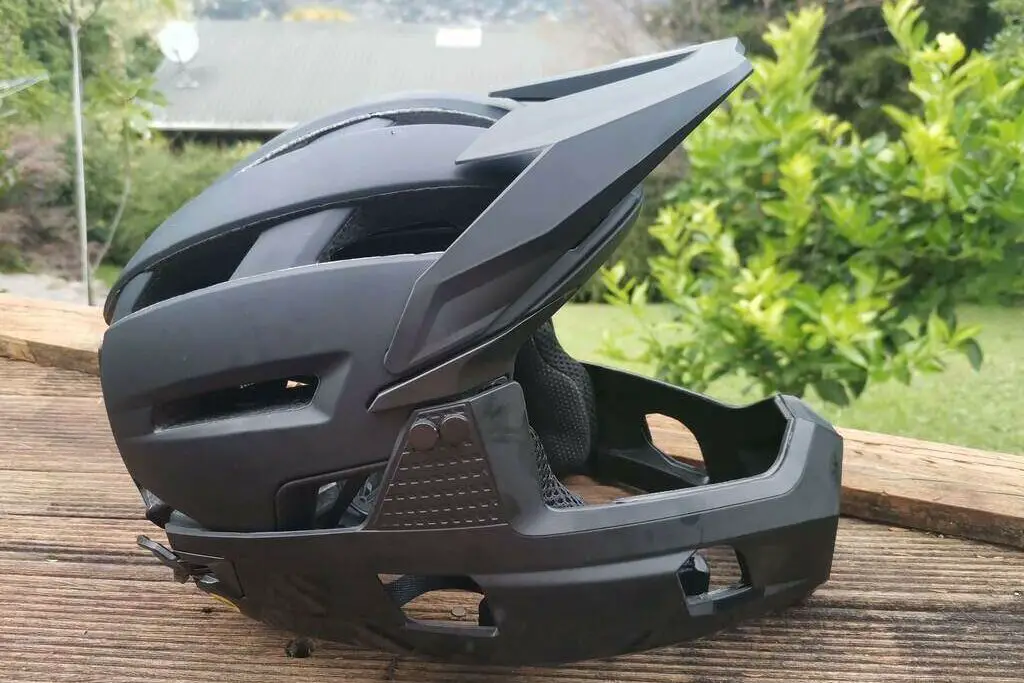
Features
Just like the helmets in the Bell Super range, the chin bar is simple to attach and detach. Two clips. There is no Fidlock buckle unlike the Super DH, but it does have the same easy to use retention dial, and a three position adjustable visor.
The visor does sit high enough that eye wear can easily be stored beneath the visor when not in use. Additionally, the rear of the helmet has a flatish area which I can only assume is designed for goggle straps!
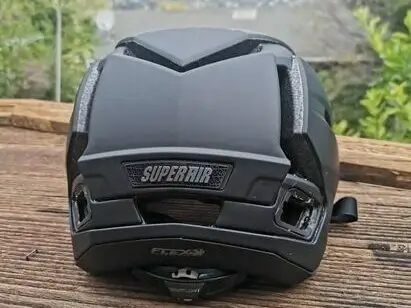
Safety
The Bell Super Air R uses MIPS Spherical, similar to the Super DH. The two separate layers of EPP and EPS provide the best possible protection in both slow and high-speed crashes.
The main difference between the Super DH and the Super Air R is that the Super DH is downhill certified, while the Air R is not. The Super Air R does not have enough
Ventilation
Ventilation on the Super Air R is fantastic as both a half shell and full face. As a convertible helmet, it is in a league of its own. Comparable to the likes of the Specialized Ambush as a half shell, there is no complaints on the ventilation front!
My favorite part about the helmet is that it doesn’t squash my face as a full-face helmet. I don’t enjoy having padding against my face while riding, which (before the Super Air R) was something I had just accepted I would have to put up with. The air can flow past my face
Bell Super 3R MIPS Helmet Review
- Rating: 4/5 – Best Bargain
- Weight: 784 g
- Downhill Certified: No
- Rotational Impact System: MIPS
Well ventilated, very light, and very comfortable. This is the ideal helmet for the typical rider, not riding the extreme lines at extreme speeds, but wanting more protection than an open-face helmet can provide.
Pros
- Light
- Comfortable
- Well Ventilated
- Provides Face Protection
Cons
- Not Downhill Certified
Bell has designed a clever helmet for all-mountain terrain. While it is not downhill certified, it provides sufficient protection for those not taking on the extreme lines. It is more of a lightweight and better-ventilated version of the more grunty Super DH.
Features of the Super 3R
The Bell Super 3R features a reasonably new feature by Bell, the Float Fit retention system. This is essentially an upgraded fitting system so that the helmet sits snug around your face. It makes it extremely comfortable to wear and is seamlessly integrated with the MIPS system. It provides improved comfort and no hindrance to the ventilation of the system.
Another handy feature of the helmet is the strapping system, which features what Bell likes to call the ‘No-Twist Tri-Glides.’ These keep the straps flat against your head, under your airs and chin, which makes the straps a bit more comfortable and easier to use. The adjustable visor has enough range to be able to fit goggles underneath, so no more wearing the goggles around your neck either!
Safety Features of the Super 3R
Despite not being a certified downhill helmet, the Super 3R is certified by the US, Canada, Australia, and New Zealand standards for safety standards. It is MIPS equipped, which is an essential piece of technology that protects your head from angular impacts, preventing brain injury.
Ventilation
With 23 vents, the helmet was never going to be a hot and sticky one. And with the addition of 4 ports on the brow and six on the chin-bar, which takes in the air as you are riding and circulates it through the airflow matrix of the helmet, it actually keeps the whole head reasonably cool with or without the chin bar attached.
Met Parachute Convertible Helmet Review
- Rating: 4.5- Best overall
- Weight: 840 g
- Downhill Certified: Yes
- Rotational Impact System: MIPS

Pros
- Light
- Breathable
- Downhill certified
- Durable
- Easy to convert
Cons
- Expensive
- Visor sits high
- Tricky to get on and off your head with the chin guard attached
For a sleek, comfortable and super protective helmet, the Met Parachute MCR is a newcomer to the convertible game. Named after its magnetic chinbar release (MCR) system, the helmet is kitted out with endless features.
Features
The fit system is adjusted using the Boa retention system. For those that are unaware, Boa is well known for their shoe tightening system. The circular dial rachets the fit system (whether it is the helmet or the shoe) in very small increments so you can get the perfect fit.
The buckle is fastened using the Fidlock magnetic system, as we have seen in many of the other high end helmets these days.
The visor is adjustable, but only to two locations (which seem to be high and higher). Its flexible in the case of a crash too (won’t bend your neck at funny angles).
And last but not least, the MCR system to attach and detatch the chin bar. It is a wonderful system, easily the easiest system to use for the chin bar. In a matter of seconds, you can have the chin bar on and off, it is sturdy, and there is no way it. is accidentally popping undone.
While attaching the chin bar is super easy, actually getting it on and off your head can be a challenge. You essentially need to undo the dial at the rear of the helmet in order to get it over your head, otherwise it is quite a squeeze!
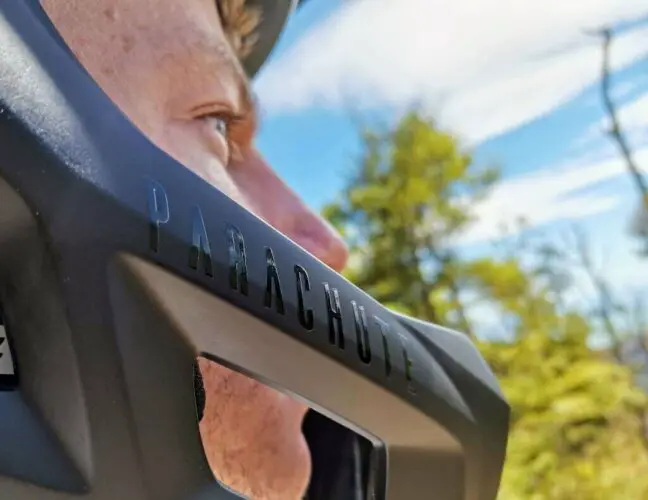
Safety
The Parachute MCR is downhill certified, so its a bit gruntier than the Super Air R and the Super 3R (both listed above). The helmet has MIPS to minimise the chance of brain injury, and excellent coverage around the head to protect against any awkward crashes.
Ventilation
While still better than a typical full face, it does not breathe as well as the lighter options such as the Super Air R, or even the Bell Super DH. This is certainly one aspect Met could work on for the next model, but regardless, the air will still be flowing over your head at an acceptable rate.
Giro Switchblade Mountain Bike Helmet Review
- Rating: 3.5/5 – Best Protection
- Weight: 1100 g
- Downhill Certified: Yes
- Rotational Impact System: MIPS
Hot and heavy, but is downhill certified as both a full face and open face helmet. In terms of safety, it is hard to beat, so ideal for the rider who wants to be sending those park laps with confidence.
Pros
- Good Safety Performance
- Goggle Compatibility
- Durable
Cons
- Poor Ventilation
- Heavy
The original Switchblade was actually released back in 1998, making it the first convertible helmet on the market. Giro has brought back the style, making a few improvements, and it has made a presence in the enduro category of riding.
Features
The unique thing about the Switchblade is that Giro has decided to keep the over-ear protection and cheek pads once the chin bar has been removed. Usually, the convertible helmets detach above the ears, exposing your ears and cheeks once the chin bar has been removed, which increases ventilation, replicating an open face helmet. However, Giro has chosen not to do this on the Switchblade, making it a bit warmer and very different looking when in ‘open-face’ mode. It is not a light full-face helmet either.
At 1100g (medium) when in full-face, or 800g without the chin bar, your head definitely won’t be cold while riding! The ventilation also suffers because of the design, very close to the face with heavy padding. It almost has a design similar to a motorcycle helmet rather than a modern downhill helmet. This does make it very safe though!
In terms of features, the visor has a large range, allowing for goggle storage beneath the visor when not needed. The attachment and detachment of the chin bar is reasonably simple, attaching near the cheeks with two buttons and a wiggle of the chin bar. Everything on the helmet is heavy-duty, including the padding, the chin bar mounts and the visor. So it easy to say it is a very durable helmet.
Safety Features
The Switchblade is ASTM downhill certified, with a MIPS liner protecting from the rotational impacts. Because of the additional protection over the cheeks, it is one of the safest helmets on the market in both full-face and open-face modes!
There isn’t too much to note in terms of fancy safety features. But the Switchblade is just a solid, durable, heavy-duty kind of helmet. You will instantly feel safe as soon as it is on your head.
Ventilation
The ventilation isn’t fantastic when compared to the other convertible helmets. But keep in mind that it is better than many other full-face helmets out there. So if you are looking for a rock-solid, made-to-last helmet, ventilation probably isn’t the most important feature you will be looking for.
The Switchblade is a sturdy design, and given its primary job is to protect your head in the event of a collision, it will do its job extremely well. Your safety while riding does come at a cost- it will be a hot and heavy ride. But if this doesn’t matter too much to you, and you would rather keep your head well protected, then the Switchblade is certainly a good option!
Leatt DBX 3.0 Enduro Helmet Review
- Our Rating: 4/5 – Lightest Weight
- Weight: 760 g
- Downhill Certified: No
- Rotational Impact System: Turbine 360
Perfect for the enduro rider- well ventilated, comfortable, and breathable, but not necessarily our first choice of downhill specific helmet. Still, a very good option for those wanting great protection and an all-around great convertible helmet, but aren't hitting gnarly lines at fast speeds.
Pros
- Turbine 360 Technology
- Well Ventilated
- Light
Cons
- Flimsy Reattachment of Chin bar
- Not as comfortable for many heads
Leatt has earned itself a reputable name following its success in neck braces and other safety equipment. The DBX 3.0 is a light and comfortable convertible full-face helmet, aimed at the enduro rider wanting the use of two but the practicality of having one helmet.
Features of the Leatt DBX 3.0
The length of the visor works well for the full-face without looking stupidly long on the half-shell and lifts up just high enough to store some average-sized goggles beneath it. The buckle is the FidLock magnetic buckle system, which becomes second nature after a few practices.
As a half-shell, the helmet is particularly sturdy and very light. The chin bar is attached and removed with ease around the sides of the helmet. The primary issue with the DBX 3.0 is the reattachment system is somewhat flimsy. It attaches with two small buckles, which we are certain to have been tested for safety and durability, but seem not as sturdy as we would want to expect from an enduro helmet.
Safety Features of the Leatt DBX 3.0
The DBX 3.0 Enduro offers Leatts Turbine 360 technology, which essentially mimics MIPS technology. The ‘turbines’ which attach to the EPS foam layer, act to reduce any rotational impact to lessen the potential of brain damage. The Turbines have the advantage over MIPS as they reduce direct impacts as well as rotational impacts, so you aren’t just relying on the foam layers.
It is not fully downhill certified, similar to the Bell Super 3R, as it is aimed at being lighter weight and better ventilated. If it was downhill certified, it would require a bit more bulk. However, it still meets helmet safety standards around the world. But it also has the advantage of the chin bar to prevent the face from collecting any dirt on the way down.
It is still is an ideal helmet for a rider who doesn’t need anything extensive or bulky. It is perfect for someone wanting a safe helmet that is light and well ventilated with the reassurance of having the chin bar just in case!
Ventilation
As the helmet is aimed at providing an enduro rider with the ultimate helmet, ventilation is was a top priority for the DBX 3.0. There are 18 vents, including one above the brow line. The over brow vent takes in the air as you ride and circulates it through the helmet. It is even covered with a screen to prevent debris from entering or blocking the airflow. The chin bar also has three ventilation ports to increase airflow, as well as one above each ear near where the chin bar attaches.
In terms of performance as a full-face, it is similar to that of the Bell Super 3R. Ideal for the enduro rider in terms of ventilation, comfort, and breathability. But it is not one we would take off the shelf for a gnarly downhill session.
Final Remarks
Personally, I love using a convertible helmet. I likely won’t go back to buying a standard half-shell or full face for as long any time soon. The practicality of having two helmets with a simple buckle to connect them is just too convenient to pass up!
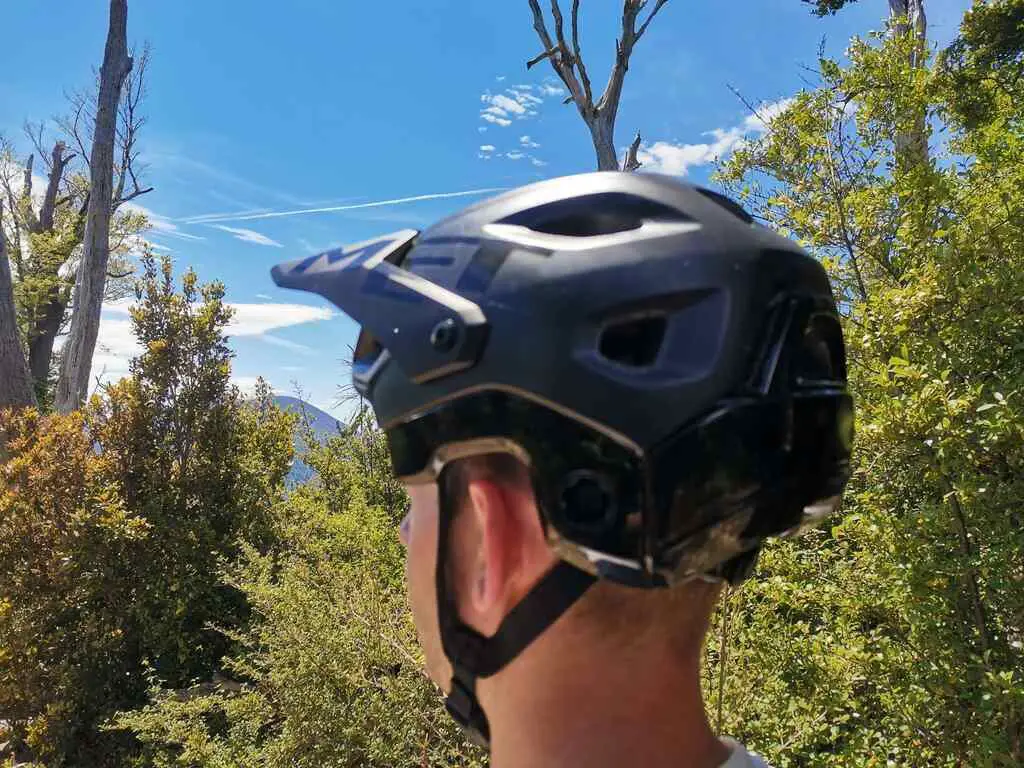
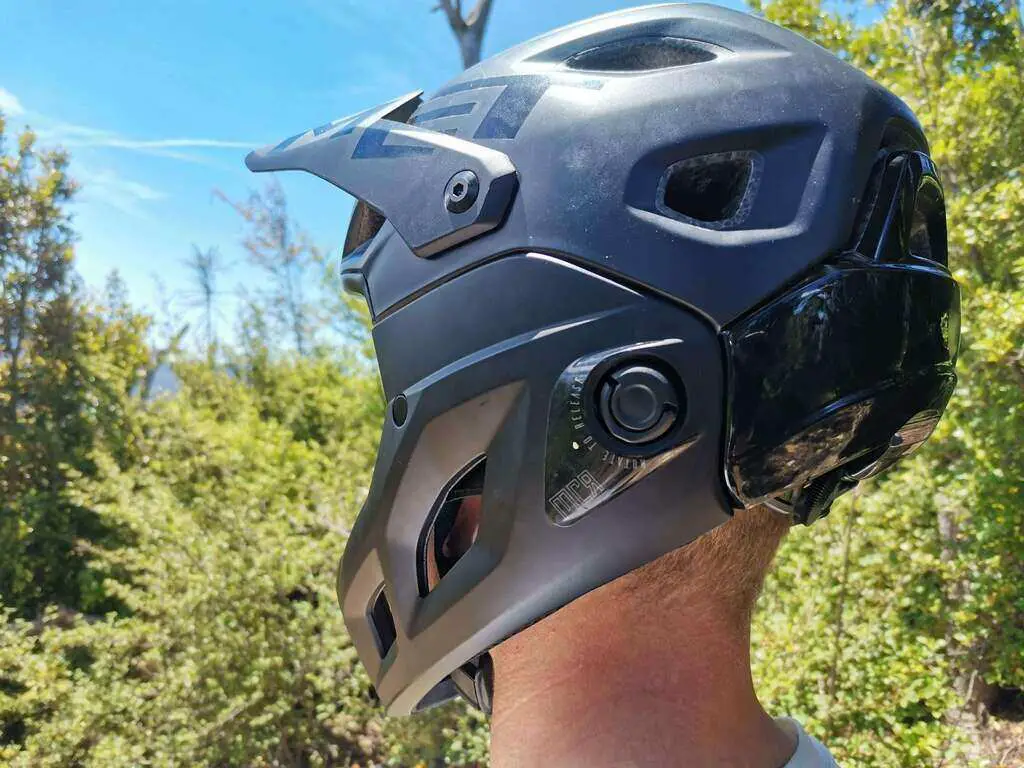
So which convertible helmet is right for you?
Finding the right one for you depends on your type of riding, the terrain, how much you use it and obviously, your budget.
Our personal favorites are the MET Parachute MCR and the Bell Super Air R. The Parachute MCR is comfortable, feels very solid and secure, and just looks really nice. The Bell Super Air R is roomy, comfortable, very lightweight, and while not DH rated, will still keep me more protected than a standard half shell.
The Bell Super DH and the Met Parachute MCR are both good choices if you do any sort of gnarly descents, but still want a helmet for any other type of terrain. These do come at a cost, but if you consider the fact that you are actually getting two helmets in a single purchase, it is actually an incredible deal. Also, you are paying for the convenience of not having to lug around two helmets if you decide to ride varying terrain.
For riding where you don’t particularly care about ventilation or weight, the Giro Switchblade is one of the more protective models out there.
The Bell Super 3R, Bell Super Air R and the Leatt DBX 3.0 are not downhill certified but are aimed at those wanting to protect themselves a bit more on day-to-day riding. They haven’t been designed for the gnarly rocky descents but are perfect if you just want to feel more confident at tackling new sections at your local bike park.
Personal Recommendations
Our personal favorites are the MET Parachute MCR and the Bell Super Air R for our day to day riding and racing!
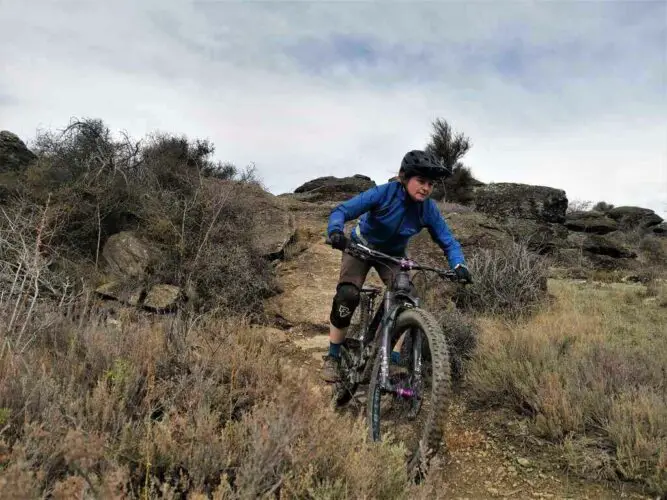
We have had a look at a few comparisons of these helmets if you still can’t decide!
- Bell Super DH vs Bell Super 3R
- Bell Super DH vs Bell Super Air R
- Leatt DBX and Bell Super 3R
If you’re looking for a head-to-head comparison on the Leatt DBX and Bell Super 3R, check out our in-depth comparison here, or check out the comparison between the Bell Super DH and the Bell Super 3R.
